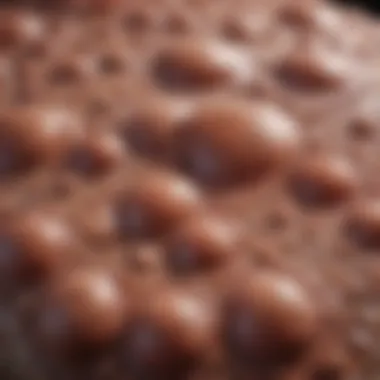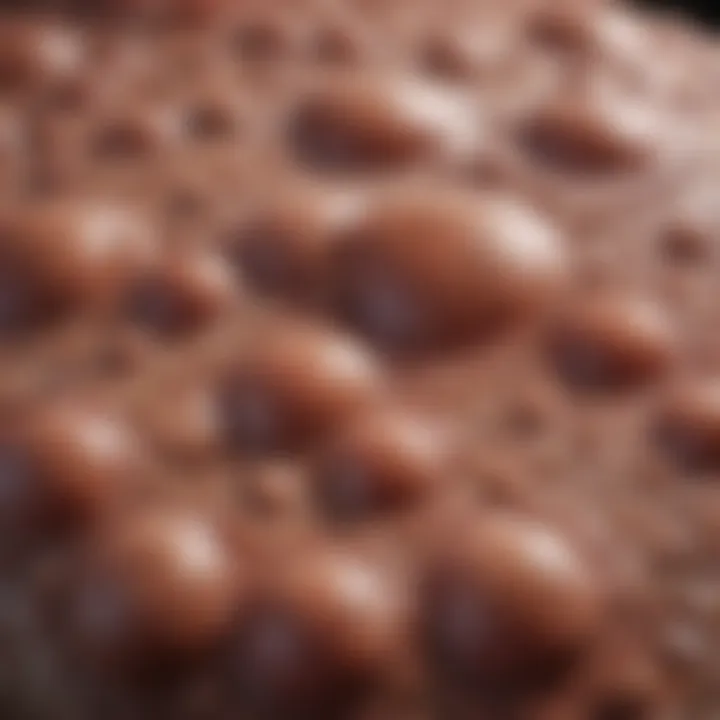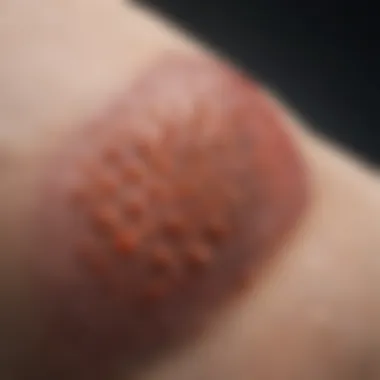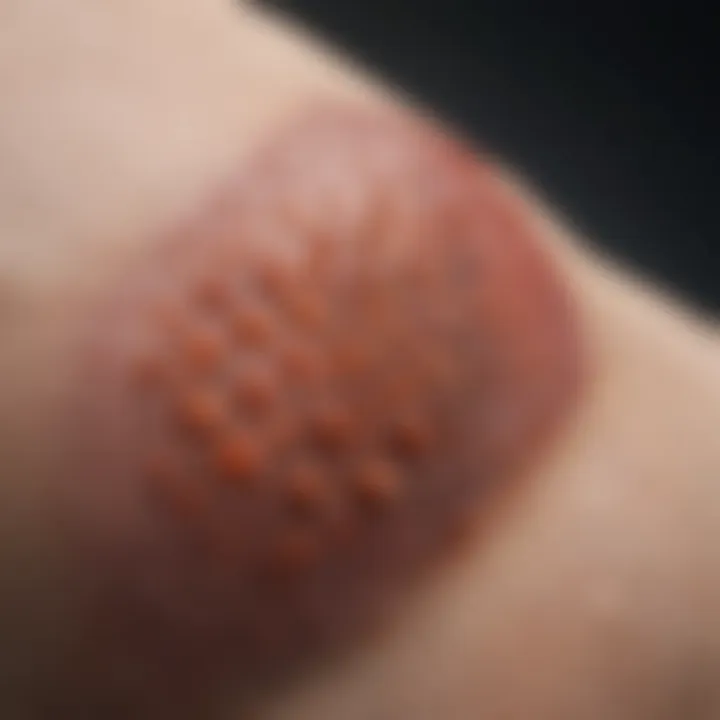Understanding Liver Spots: Causes and Implications


Intro
Liver spots, commonly known as age spots, present a frequent concern as people age. These small, usually brown or black marks can appear on various parts of the skin, predominantly where exposure to the sun has been greatest. While the term liver spots can evoke thoughts of medical issues related to the liver, it is important to note that these pigments have no direct connection to liver function. Instead, they are a result of prolonged skin exposure to ultraviolet (UV) radiation and aging.
This article seeks to explore the underlying causes and implications of liver spots. We'll delve into how skin pigmentation changes with age, the biological mechanisms behind the development of these spots, and the lifestyle factors that may contribute. By shedding light on these topics, we intend to eliminate misconceptions surrounding liver spots and promote a nuanced understanding of skin health among our audience.
Preface to Liver Spots
Liver spots, commonly known as age spots, have gained significant attention in both clinical and social discussions surrounding skin health. Their prominence as a visible sign of aging raises questions not just about aesthetics, but also about the biological mechanisms involved in their formation. Understanding liver spots is crucial, especially for those interested in dermatology, gerontology, or overall health management.
This article aims to unpack the complexities associated with liver spots, bridging the gap between biological science and real-world implications. By exploring their definition, causes, and the factors influencing their appearance, we can better appreciate how skin aging reflects broader health issues. Moreover, the implications of liver spots go beyond mere pigmentation; they touch on cultural perceptions, social stigmas, and individual self-esteem, making this topic relevant to a wide audience.
Informed discussions around liver spots can lead to better prevention and treatment strategies, enhancing public awareness and education on skin health.
Definition and Terminology
Liver spots are flat, brown, gray, or black patches that often appear on sun-exposed areas of the skin, such as the face, hands, shoulders, and arms. They can vary in size, from a few millimeters to several centimeters across. The term "liver spot" can be misleading. It does not indicate that the liver is responsible for their formation, nor do they have any direct correlation with liver health. Instead, the origin of the name is likely linked to the color resemblance to liver tissue.
The scientific term for these spots is "solar lentigines". They occur due to an increase in melanin production, the pigment responsible for skin color. With age, skin's ability to regenerate and repair diminishes, leading to the accumulation of melanin in specific areas, which manifests as liver spots. Educating ourselves with the correct terminology helps demystify these blemishes and contributes to a more informed public discourse.
"Liver spots are common and generally harmless, but understanding their biology is essential for effective management and treatment."
Biological Mechanisms Behind Liver Spots
Understanding the biological mechanisms behind liver spots is crucial for several reasons. First, these mechanisms provide insight into how liver spots, or age spots, develop over time. Analyzing the underlying biological processes not only demystifies liver spots but also informs better prevention and treatment strategies. By recognizing the skin's structure and the role of melanocytes, we gain valuable knowledge about the interaction between external factors and the body's natural aging process.
Skin Structure and Function
The skin is a complex organ comprised of multiple layers, each with distinct functions. The outermost layer is the epidermis, which serves to protect underlying structures from external environments. Beneath the epidermis lies the dermis, which houses blood vessels, nerves, and connective tissue. This layered architecture plays a significant role in the appearance of liver spots.
In the epidermis, keratinocytes are the predominant cell types. They undergo a continuous cycle of proliferation and differentiation, contributing to the skin's barrier function. However, as individuals age, this function gradually diminishes, causing various skin changes, including the formation of liver spots.
The dermis is rich in collagen and elastin fibers, providing structural support. Over time, the accumulation of sun exposure and other environmental factors can lead to alterations in the dermal matrix, further exacerbating the skin's aging process. This enables pigmentation changes in the epidermis, as underlying damage often affects melanocyte activity, ultimately resulting in hyperpigmented areas or liver spots.
Role of Melanocytes
Melanocytes are specialized cells located in the basal layer of the epidermis. Their primary function is to produce melanin, the pigment responsible for skin coloration. The balance of melanin production is crucial for skin health. In response to ultraviolet (UV) radiation and various environmental factors, melanocytes can become overactive, leading to an overproduction of melanin. This overactivity contributes to the formation of liver spots, which typically appear as flat, brownish areas on sun-exposed skin.
The relationship between melanocytes and liver spots is significant because it highlights the role of external factors in skin health. For instance, chronic sun exposure can trigger an increase in melanocyte activity, resulting in the appearance of these spots. Additionally, the hormonal changes associated with aging also impact melanocyte function. Understanding these mechanisms emphasizes the importance of protective measures, such as proper sun protection, throughout one's life.
"The skin's reaction to environmental stressors showcases the inherent adaptiveness of our biology, but it can also lead to unintended consequences, such as liver spots."
Contributing Factors to Liver Spot Formation
Understanding the contributing factors to liver spots is crucial in grasping how these phenomena develop on the skin. These spots, often mistaken for more serious conditions, can reveal important insights into one's skin health. Various factors play a role, including sun exposure, genetic predisposition, hormonal changes, and the natural aging process of the skin. Each of these elements interacts in complex ways and influences the likelihood of developing liver spots.
Sun Exposure and UV Radiation
Sun exposure is perhaps the most significant factor influencing the appearance of liver spots. Ultraviolet (UV) radiation from the sun triggers an increase in melanin production in the skin. Melanin is the pigment responsible for the color of our skin. Over time, chronic exposure to UV radiation leads to uneven melanin distribution, resulting in age spots.
Statistics show that people who spend considerable time in the sun without adequate protection are at a higher risk. Protective measures, such as sunscreen, can mitigate this risk significantly. It is important to apply a broad-spectrum sunscreen with a high SPF, even on cloudy days, because UV rays can penetrate clouds. This vigilance helps to minimize skin damage and prevents premature aging, which can contribute further to liver spot formation.
Genetics and Familial Patterns
Genetic factors also contribute to the development of liver spots. Individuals with a family history of liver spots are more likely to develop them themselves. Genetic predisposition can dictate how one's skin responds to environmental triggers, like sun exposure. The specific genes involved in pigmentation can influence melanin production and distribution, making some individuals more susceptible to age spots than others.
Furthermore, researchers have identified certain familial patterns associated with pigmentary disorders. These findings underscore the importance of understanding one’s family health history, especially when evaluating skin conditions.
Hormonal Changes


Hormonal fluctuations, particularly those associated with pregnancy, menopause, or hormonal therapies, can lead to changes in melanin production. For example, during pregnancy, many women experience a condition called melasma, which results in brown patches on the face, often mistaken for liver spots.
The hormones progesterone and estrogen are thought to influence these changes. These hormonal shifts can alter the skin’s response to sunlight, leading to increased pigmentation in some areas. Understanding these hormonal influences can be crucial for developing appropriate prevention and treatment strategies for liver spots.
Age and Skin Aging Process
Age is an undeniable factor in the formation of liver spots. As people age, their skin naturally undergoes changes due to a decrease in collagen and elastin production. Additionally, the skin may become thinner and less capable of regenerating itself, leading to an increased susceptibility to liver spots.
The aging process also involves a longer history of sun exposure, which compounds the effects of UV radiation over time. This cumulative damage leads to the gradual appearance of age spots in various areas of the body, particularly on sun-exposed skin, such as the hands, face, and arms.
Regular skin check-ups can help monitor changes and catch problematic spots early.
In summary, liver spots are influenced by a interplay of factors. These include UV exposure, genetic predispositions, hormonal shifts, and the natural aging process. Recognizing these factors can guide individuals toward better skin care practices, proactive prevention measures, and informed discussions about skin health.
Types of Liver Spots
Understanding the types of liver spots is essential for grasping their significance in skin health. Differentiating between various forms of pigmentation allows for better diagnosis and treatment, as well as a deeper understanding of their causes. Liver spots, or age spots, vary in appearance and origin. Recognizing these differences can inform both prevention strategies and aesthetic preferences, serving to guide individuals toward healthier skin management practices.
Common Age Spots
Common age spots, known scientifically as solar lentigines, are prevalent among older adults and are primarily the result of prolonged sun exposure. These spots typically appear on areas frequently exposed to sunlight, such as the face, hands, shoulders, and arms. They vary in size and color but are usually flat and brownish.
The formation of these spots correlates with an increase in melanin production due to oxidative damage from UV rays. While they are generally harmless, their presence can indicate significant sun damage. Familiarity with common age spots helps individuals identify potentially harmful changes in their skin. Monitoring these spots can lead to early detection of more serious skin conditions.
Key characteristics of common age spots include:
- Flat and rounded: They are often smooth and rise slightly from the skin.
- Color variations: Colors range from light brown to dark brown, depending on genetic factors and sun exposure.
- Common locations: They frequently occur on sun-exposed areas of the body.
Early recognition is key. If someone notices changes, such as sudden growth or changes in color, consulting with a dermatologist is advisable for further evaluation.
Lentigines and Other Variants
Lentigines represent a broader category of pigmentation disorders. While common age spots fall under this term, lentigines also encompass other types, like lentigo simplex and lentigo senilis. These forms are not necessarily related to sun exposure and can appear in younger individuals as well.
Lentigo simplex usually appears in childhood or adolescence. Conversely, lentigo senilis emerges with aging, reflecting cumulative sun damage. These lentigines may vary in size, shape, and color but often share a common characteristic: a smooth texture and well-defined borders.
Other variants include:
- Actinic lentigines: These spots appear due to chronic sun damage. They can be mistaken for common age spots, but they are more likely associated with significant skin damage.
- Periorbital lentigines: These lentigines form around the eyes. They can signify both aging and sun exposure.
In summary, understanding the different types of liver spots facilitates informed conversations about skin health and encourages proactive care. A competent recognition of these conditions plays an important role in proper dermatological diagnosis and the development of tailored treatment strategies.
Diagnosis of Liver Spots
Diagnosing liver spots is a fundamental aspect of understanding their implications for skin health. Given that these spots are often benign, their identification is crucial in distinguishing them from potential skin conditions that may require medical attention. As professionals and researchers in the field explore the connection between skin changes and aging, diagnosis plays a key role in effective management and preventive strategies.
To properly diagnose liver spots, healthcare providers typically follow a series of steps. These steps help ensure that an accurate assessment is made, minimizing the risk of misdiagnosis. A detailed clinical evaluation often includes a patient’s medical history, a physical examination, and, in some cases, additional diagnostic techniques.
Clinical Evaluation Techniques
Clinical evaluation techniques are essential in the diagnosis of liver spots. During a patient consultation, the clinician will review the patient's history, which can reveal patterns related to sun exposure and familial trends. A thorough understanding of these factors can assist in confirming the benign nature of the spots. In addition to historical data, clinicians will assess the appearance and characteristics of the spots, looking for specific traits such as color variations, size, and distribution.
Some common evaluation points include:
- Color: Typical liver spots are brown or black but may vary in shades. Clinicians look for unusual colors.
- Size: The size of the spots can indicate differing types, with larger spots possibly requiring further evaluation.
- Symmetry: Symmetrical spots are more commonly benign compared to asymmetrical ones, which can be a warning sign.
- Growth Patterns: Any changes in size or number of spots over time may raise concern and require closer inspection.
Regular skin examinations are also advocated, especially for individuals over the age of 50 or those with a history of significant sun exposure. Recommendations for routine check-ups emphasize early detection, which is vital in ensuring skin health.
Dermatoscopic Examination
Dermatoscopic examination is a specialized technique used to enhance the diagnosis of liver spots. This noninvasive procedure employs a dermatoscope, a handheld instrument equipped with a magnifying lens and a light source. Dermatoscopy allows dermatologists to observe the structural characteristics of skin lesions in greater detail.


When conducting a dermatoscopic examination, clinicians look for certain features that distinguish liver spots from potentially dangerous pathologies, including:
- Shape and Border: Well-defined shapes and even borders are indicators of benign spots. Irregular borders may require a biopsy.
- Color Patterns: The presence of uniform coloration throughout liver spots is generally reassuring; however, heterogeneous coloration could signify deeper issues.
- Vascularity: Lack of abnormal blood vessels is a positive sign, while the presence of atypical vessels can alert clinicians about the need for further intervention.
"The dermatoscopic examination serves as a bridge between simple visual inspection and invasive procedures, allowing for a more precise clinical judgment."
In summary, effective diagnosis of liver spots includes combining clinical evaluation with dermatoscopic techniques. Understanding these methods helps patients gain confidence in their diagnosis and encourages proactive engagement in managing skin health as they age. Knowledge surrounding the characteristics of liver spots is vital, offering a pathway for individuals to understand their skin better.
Preventive Measures for Liver Spots
Preventive measures for liver spots, or age spots, play a vital role in not only the maintenance of skin health but also the enhancement of one’s overall appearance. These measures aim to mitigate the formation of these pigmented lesions, which are often seen as undesirable to many. Understanding and implementing strategies for prevention can lead to significant benefits, including reduced incidence of new spots, maintenance of an even skin tone, and overall improved skin quality. Heres what individuals can do to shield themselves against these changes.
Photoprotection Strategies
Photoprotection is the first line of defense against liver spots. The sun’s ultraviolet rays have a direct and damaging impact on skin pigmentation. Here are several specific strategies to consider:
- Broad-spectrum Sunscreen: Use a broad-spectrum sunscreen with an SPF of at least 30 daily. This shields against both UVA and UVB rays. Apply it generously on all exposed skin, even on cloudy days.
- Reapplication: Reapply sunscreen every two hours, or more often if swimming or sweating. Sunscreen’s effectiveness decreases over time, especially in high-exposure situations.
- Protective Clothing: Wearing clothing that covers the skin, such as long sleeves and wide-brimmed hats, can lessen sun exposure. Fabrics with a high ultraviolet protection factor (UPF) add an extra layer of defense.
- Avoiding Peak Sun Hours: Try to limit sun exposure during peak hours, usually between 10 a.m. and 4 p.m. When UV radiation is strongest, it is beneficial to seek shade whenever possible.
In summary, consistent sun protection can significantly reduce the risk of developing liver spots through minimizing ultraviolet damage to the skin.
Lifestyle Modifications
Beyond photoprotection, various lifestyle modifications can serve to reduce the likelihood of developing liver spots. These changes can enhance skin health and overall well-being. Important considerations include:
- Nutrition: A diet abundant in antioxidants can help protect skin from cellular damage. Foods rich in vitamins C and E, such as citrus fruits, nuts, and green leafy vegetables, promote skin repair and resilience.
- Hydration: Proper hydration is crucial for skin health. Drinking sufficient water daily helps maintain skin moisture and elasticity, which can combat the signs of aging.
- Avoiding Smoking: Tobacco use can significantly contribute to premature skin aging. Quitting smoking can help in preserving skin texture and tone.
- Regular Skin Checks: Monitoring skin regularly for changes or new spots allows for early detection and intervention if necessary. Seek medical advice if any new spots appear or existing spots change in color or shape.
By implementing these simple yet effective strategies, individuals can take significant steps towards preventing the formation of liver spots. These preventive measures contribute not only to healthier skin but also to a better understanding of skin care in general.
Treatment Options for Liver Spots
Understanding effective treatment options for liver spots is crucial. Such knowledge plays an important role in skin health management. Liver spots, while generally harmless, can sometimes cause concern due to their appearance. Hence, exploring various treatment methods can empower individuals to make informed decisions. These options can help diminish the visibility of these spots, enhance skin texture, and restore confidence. People should consider their skin type, the severity of pigmentation, and potential side effects before opting for a particular treatment.
Topical Agents and Creams
Topical agents and creams are often the first line of treatment for liver spots. They come in different formulations and can significantly lighten pigmentation over time. Common ingredients known for their efficacy include hydroquinone, tretinoin, and kojic acid. These compounds work by reducing melanin production in the skin and promoting skin cell turnover.
- Hydroquinone: This is a powerful skin-lightening agent. It is known to decrease skin discoloration and even skin tone. However, prolonged use can cause skin irritation, so it should be used with caution.
- Tretinoin: A derivative of vitamin A, tretinoin stimulates cell turnover. This process encourages the shedding of pigmented skin cells, allowing healthier skin to emerge.
- Kojic Acid: Another natural agent that reduces melanin production. It is often considered a gentler alternative to hydroquinone.
It is important to note that results can vary widely among individuals. Some may see improvements within a few weeks, while others may require longer usage. Consistency is key, alongside sun protection to prevent further darkening.
Laser Treatment and Other Procedures
For individuals seeking quicker or more immediate results, laser treatments offer a more aggressive yet effective avenue. Various types of laser treatments can target pigmentation with precision, leading to significant improvements in skin appearance.
- Ablative Lasers: These lasers remove the outer layers of skin to eliminate pigmented areas directly. This can lead to significant results but often requires more recovery time.
- Non-ablative Lasers: These work by penetrating the deeper layers of skin without damaging the surface. This method induces collagen production, leading to overall skin improvement in texture and tone, with minimal downtime compared to ablative treatments.
- Intense Pulsed Light (IPL): IPL is not a laser per se but uses broad spectrum light to reduce pigmentation. It can effectively treat liver spots, often requiring multiple sessions for optimal results.
Before pursuing laser treatments, patients should consult with dermatologists to evaluate their skin type and the most appropriate method. Each procedure comes with benefits as well as potential side effects, including redness, swelling, or changes in skin texture.
Common Misconceptions about Liver Spots
Liver spots, or age spots, can often lead to confusion and misunderstandings. This section aims to clarify prevalent misconceptions surrounding liver spots. Understanding these myths can foster more informed discussions about skin health. Additionally, dispelling misunderstandings encourages proper preventive measures and treatment options.
Link to Liver Health
One significant misconception is the notion that liver spots indicate poor liver health. This idea stems from the term "liver spots" itself, which implies a connection to liver function. However, the presence of these spots is primarily linked to skin aging and sun exposure. They are not symptomatic of liver disease or dysfunction. Reports in medical literature largely support this distinction, reiterating that liver spots do not serve as markers for liver health.
Liver health concerns are vastly different and encompass symptoms such as jaundice, fatigue, or abdominal pain.
Association with Skin Cancer
Another common myth relates to the association between liver spots and skin cancer. Many assume that the appearance of liver spots signifies the onset of skin malignancies. While it is essential to monitor any changes in skin appearance, it is crucial to note that most liver spots are benign. Dermatological studies have consistently shown that liver spots rarely progress to skin cancer. Regular dermatological check-ups can help distinguish between benign age-related pigmentation changes and potential complications.


In summary, although awareness of liver spots is vital, separating fact from fallacy can mitigate unnecessary anxiety. Understanding these aspects ensures a healthy approach to skin care.
Cultural and Social Perceptions
Cultural and social perceptions surrounding liver spots extend beyond mere aesthetics. They intertwine with broader conversations regarding aging, identity, and self-worth. Liver spots, often heralded as markers of age, can trigger feelings of discomfort or embarrassment in individuals. The stigmas associated with aging manifest not only in physical appearance but also in how society treats older adults. Being judged based on visible signs of aging can lead to negative self-perception and social isolation.
Stigmas Associated with Aging
The stigma linked to aging is prevalent in many cultures. Regretfully, society often equates youth with beauty and vitality. This perception can render individuals with liver spots as less appealing or even marginalized. Yet, recognizing these marks as natural consequences of life experiences is crucial.
- Cultural Narratives: Various cultures idolize youth. Advertisements and media often reinforce these narratives, showcasing youthful skin as the ideal. As a result, those with liver spots may feel pressure to hide or diminish their visibility.
- Impact on Identity: Older adults may grapple with their identity as their appearance changes. Liver spots could be an external reminder of mortality and the passage of time. These feelings can sometimes manifest in anxiety and depression.
In discussing liver spots, it is essential to challenge these societal norms and provide a more inclusive viewpoint on aging.
Appearance and Self-Esteem
The impact of liver spots on one's self-esteem cannot be overlooked. Many individuals find their self-worth intertwined with their physical appearance. When faced with skin changes, the psychological ramifications can be significant.
- Self-Image: The visibility of liver spots can alter one’s self-image significantly. Many may resort to covering them up, which can lead to increased anxiety about appearance.
- Social Interactions: The way individuals perceive themselves can impact how they engage with others. Feelings of inadequacy may hinder social interactions, leading to withdrawal from community or family events.
- Acceptance and Reframing: Nevertheless, discussions around acceptance and self-love are increasingly important. Understanding that these spots are a natural part of life can help individuals reframe how they view themselves. Empowerment movements advocate for embracing age marks as a testament to life lived, urging society to see beauty in wisdom and experience.
Cultural and social perceptions should evolve. By addressing the stigmas attached to aging and fostering a narrative focused on acceptance, individuals can regain control over their self-esteem and foster respect for the visible markers of a lifetime.
"Aging is not lost youth but a new stage of opportunity and strength." - Betty Friedan
Research Perspectives on Liver Spots
Research in the field of dermatology has advanced significantly in recent years. The study of liver spots, or age spots, is an essential aspect of this progress. Understanding why and how these skin anomalies arise is important not only for scientific knowledge but also for public health and individual wellness.
Researchers explore liver spots through various lenses. This includes the biological mechanisms behind their formation, as well as social implications they hold for individuals facing aging skin. The benefits of research are numerous. It can lead to improved diagnostic methods, better preventive strategies, and even advanced treatment options that could change the way we approach skin health overall.
Considerations around liver spots span from genetic predispositions to environmental factors, each shedding light on different elements of their occurrence. Investigating these aspects helps in identifying high-risk groups and understanding the full scope of how liver spots impact people's lives.
Current Studies and Findings
Recent studies have started to elucidate the genetic and environmental contributors to liver spot development. For instance, research indicates a noteworthy correlation between prolonged UV exposure and increased pigmentation in older adults. Findings demonstrate that those with fair skin tend to have a higher prevalence of liver spots due to their skin's limited ability to protect against UV damage.
Moreover, studies using advanced imaging techniques highlight how melanin distribution changes with age. They reveal that not only do the number of melanocytes decrease, but the existing ones become less functional over time. This dysfunction contributes to the uneven pigmentation seen in liver spots.
Additionally, some studies show that lifestyle factors, including diet and sun protection, might influence the severity and appearance of liver spots. While further research is needed, these findings already establish critical links between lifestyle choices and skin health.
Future Directions in Research
Looking ahead, the research on liver spots is poised for expansion. One significant area of interest is the role of biotechnology in developing targeted therapies for skin hyperpigmentation. Researchers are exploring the potential of gene therapy and personalized medicine in combating the effects of aging on skin pigmentation.
Future studies might also investigate the psychological impact of liver spots on individuals’ self-esteem and societal interactions. Understanding how these spots affect mental health can aid in creating comprehensive treatment plans that address both the physical and emotional aspects of skin aging.
Another promising direction is the exploration of preventive measures and public health recommendations tailored to different demographics. This could lead to community health programs aimed at educating the public about UV protection and skin care. Improving awareness can further mitigate risks associated with liver spot formation.
"Research in dermatology not only aims to treat conditions but also to prevent their occurrence."
By investigating liver spots through various methodologies and interdisciplinary approaches, the academic community can provide holistic insights into skin health. This ongoing research holds the potential to uncover solutions that enhance the quality of life for many.
Finale
In this article, the discussion around liver spots, or age spots, offers vital insights into their causes and implications. Understanding these factors is important for individuals seeking better skin health and effective preventive measures. Liver spots often signal underlying biological processes, including damage from UV exposure, genetic predispositions, and the natural aging of skin cells. Therefore, recognizing these elements can foster a proactive approach towards skin care.
Summary of Key Points
- Liver spots are primarily a manifestation of skin aging and sun exposure.
- The biological mechanisms include melanocyte activity, which leads to the accumulation of melanin.
- Genetic factors and hormonal changes also play significant roles in the development of liver spots.
- Various preventive measures can mitigate their appearance and formation.
- Treatment options range from topical agents to advanced cosmetic procedures.
This compendium outlines the intersection between clinical practice and personal skin health, helping to demystify a common concern.
Importance of Ongoing Education
Continual learning about liver spots is essential for both patients and healthcare professionals. As research advances, new treatments and preventive strategies emerge. Educating oneself ensures that individuals are equipped with recent knowledge, favorably impacting their decisions regarding skin health. Furthermore, dispelling misconceptions is crucial; many still conflate liver spots with severe health conditions or skin cancer. Ongoing education helps build awareness, fosters informed discussions, and encourages individuals to seek medical advice when needed.
Understanding liver spots is not merely about aesthetics; it encompasses a broader dialogue on skin health and aging.



